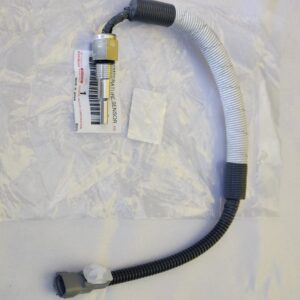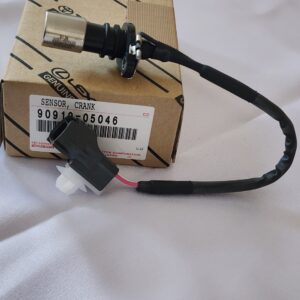Title: The Unsung Hero of Engine Performance: Unveiling the Crankshaft Sensor
Introduction:
In the intricate ballet of engine components that power your vehicle, there’s a silent observer quietly monitoring the heartbeat of your engine. Meet the crankshaft sensor, an unsung hero that plays a pivotal role in ensuring smooth engine operation and performance. In this blog, we’ll shine a spotlight on the crankshaft sensor, exploring its function, importance, and how it contributes to the driving experience.
What is a Crankshaft Sensor?
The crankshaft sensor, also known as the crank angle sensor or engine speed sensor, is a vital component of your vehicle’s engine management system. Positioned near the crankshaft, this sensor detects the rotational speed and position of the crankshaft as it spins, providing essential data to the engine control unit (ECU) or powertrain control module (PCM).
Functionality:
But how does the crankshaft sensor work its magic? As the crankshaft rotates, the sensor detects the passing of specially designed teeth or notches on the crankshaft’s reluctor wheel. This generates electrical signals that are sent to the ECU or PCM, allowing it to determine the precise position and speed of the crankshaft. This information is crucial for accurate fuel injection timing, ignition timing, and valve timing, ensuring optimal engine performance.
Importance:
The crankshaft sensor is a critical component of your vehicle’s engine management system, influencing various aspects of engine operation and performance. By providing real-time data on crankshaft position and speed, the sensor enables the ECU or PCM to adjust fuel delivery, ignition timing, and other parameters to optimize combustion efficiency and power output. Additionally, the crankshaft sensor plays a key role in enabling features such as engine starting, idle control, and misfire detection.
Common Symptoms of Crankshaft Sensor Issues:
Like any component in your vehicle, the crankshaft sensor may experience wear or failure over time. Common symptoms of crankshaft sensor issues include:
1. Engine Stalling or Misfiring: A malfunctioning crankshaft sensor may cause the engine to stall or misfire, especially during acceleration or at high speeds.
2. Difficulty Starting: A faulty crankshaft sensor can lead to difficulty starting the engine or prolonged cranking before it fires up.
3. Reduced Engine Performance: Incorrect data from the crankshaft sensor can result in decreased engine performance, including sluggish acceleration or decreased power output.
4. Check Engine Light: A malfunctioning crankshaft sensor may trigger the check engine light to illuminate on the dashboard, indicating a potential issue with the engine management system.
Maintenance and Repair:
Proper maintenance and timely repair of the crankshaft sensor are essential to ensure smooth and reliable engine operation. If you experience any symptoms of crankshaft sensor issues, it’s important to have your vehicle inspected by a qualified technician. They can diagnose the problem, replace the sensor if necessary, and perform any additional repairs to restore proper function.
Conclusion:
In conclusion, the crankshaft sensor may be small in size, but its impact on your vehicle’s engine performance is immeasurable. By monitoring crankshaft position and speed, this humble sensor enables precise control of engine operation, optimizing performance, efficiency, and reliability. So, the next time you turn the key and feel the engine roar to life, take a moment to appreciate the silent guardian working behind the scenes—the crankshaft sensor.
In stock (can be backordered)
$18,926.31
Title: The Unsung Hero of Engine Performance: Unveiling the Crankshaft Sensor
Introduction:
In the intricate ballet of engine components that power your vehicle, there’s a silent observer quietly monitoring the heartbeat of your engine. Meet the crankshaft sensor, an unsung hero that plays a pivotal role in ensuring smooth engine operation and performance. In this blog, we’ll shine a spotlight on the crankshaft sensor, exploring its function, importance, and how it contributes to the driving experience.
What is a Crankshaft Sensor?
The crankshaft sensor, also known as the crank angle sensor or engine speed sensor, is a vital component of your vehicle’s engine management system. Positioned near the crankshaft, this sensor detects the rotational speed and position of the crankshaft as it spins, providing essential data to the engine control unit (ECU) or powertrain control module (PCM).
Functionality:
But how does the crankshaft sensor work its magic? As the crankshaft rotates, the sensor detects the passing of specially designed teeth or notches on the crankshaft’s reluctor wheel. This generates electrical signals that are sent to the ECU or PCM, allowing it to determine the precise position and speed of the crankshaft. This information is crucial for accurate fuel injection timing, ignition timing, and valve timing, ensuring optimal engine performance.
Importance:
The crankshaft sensor is a critical component of your vehicle’s engine management system, influencing various aspects of engine operation and performance. By providing real-time data on crankshaft position and speed, the sensor enables the ECU or PCM to adjust fuel delivery, ignition timing, and other parameters to optimize combustion efficiency and power output. Additionally, the crankshaft sensor plays a key role in enabling features such as engine starting, idle control, and misfire detection.
Common Symptoms of Crankshaft Sensor Issues:
Like any component in your vehicle, the crankshaft sensor may experience wear or failure over time. Common symptoms of crankshaft sensor issues include:
1. Engine Stalling or Misfiring: A malfunctioning crankshaft sensor may cause the engine to stall or misfire, especially during acceleration or at high speeds.
2. Difficulty Starting: A faulty crankshaft sensor can lead to difficulty starting the engine or prolonged cranking before it fires up.
3. Reduced Engine Performance: Incorrect data from the crankshaft sensor can result in decreased engine performance, including sluggish acceleration or decreased power output.
4. Check Engine Light: A malfunctioning crankshaft sensor may trigger the check engine light to illuminate on the dashboard, indicating a potential issue with the engine management system.
Maintenance and Repair:
Proper maintenance and timely repair of the crankshaft sensor are essential to ensure smooth and reliable engine operation. If you experience any symptoms of crankshaft sensor issues, it’s important to have your vehicle inspected by a qualified technician. They can diagnose the problem, replace the sensor if necessary, and perform any additional repairs to restore proper function.
Conclusion:
In conclusion, the crankshaft sensor may be small in size, but its impact on your vehicle’s engine performance is immeasurable. By monitoring crankshaft position and speed, this humble sensor enables precise control of engine operation, optimizing performance, efficiency, and reliability. So, the next time you turn the key and feel the engine roar to life, take a moment to appreciate the silent guardian working behind the scenes—the crankshaft sensor.


Get E-mail updates about our latest products and special offers.
Sensors and More is Jamaica’s ultimate online auto parts store. Established in 2020, we specialize in genuine electrical parts for Japanese, Read more…
Reviews
There are no reviews yet.